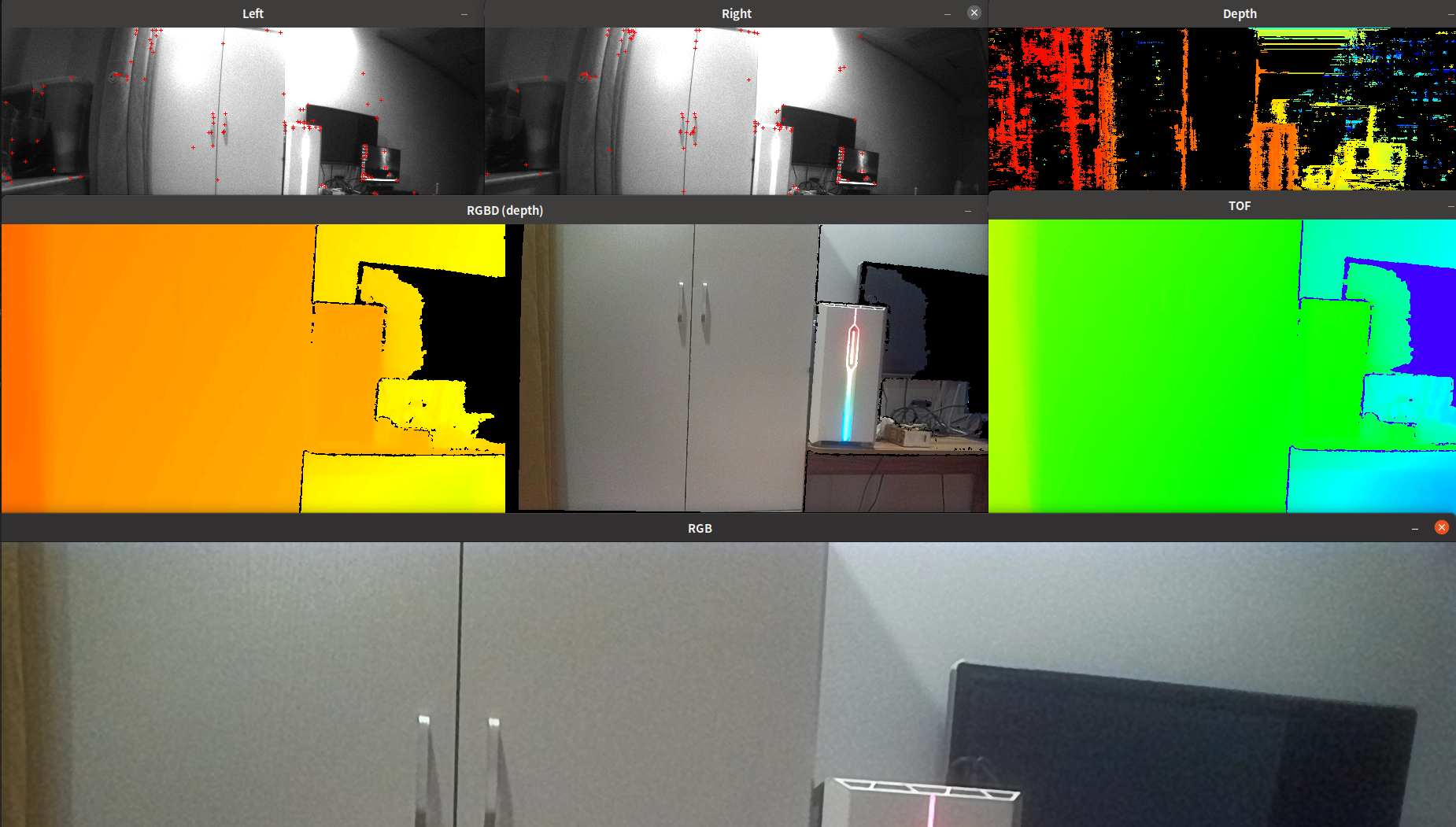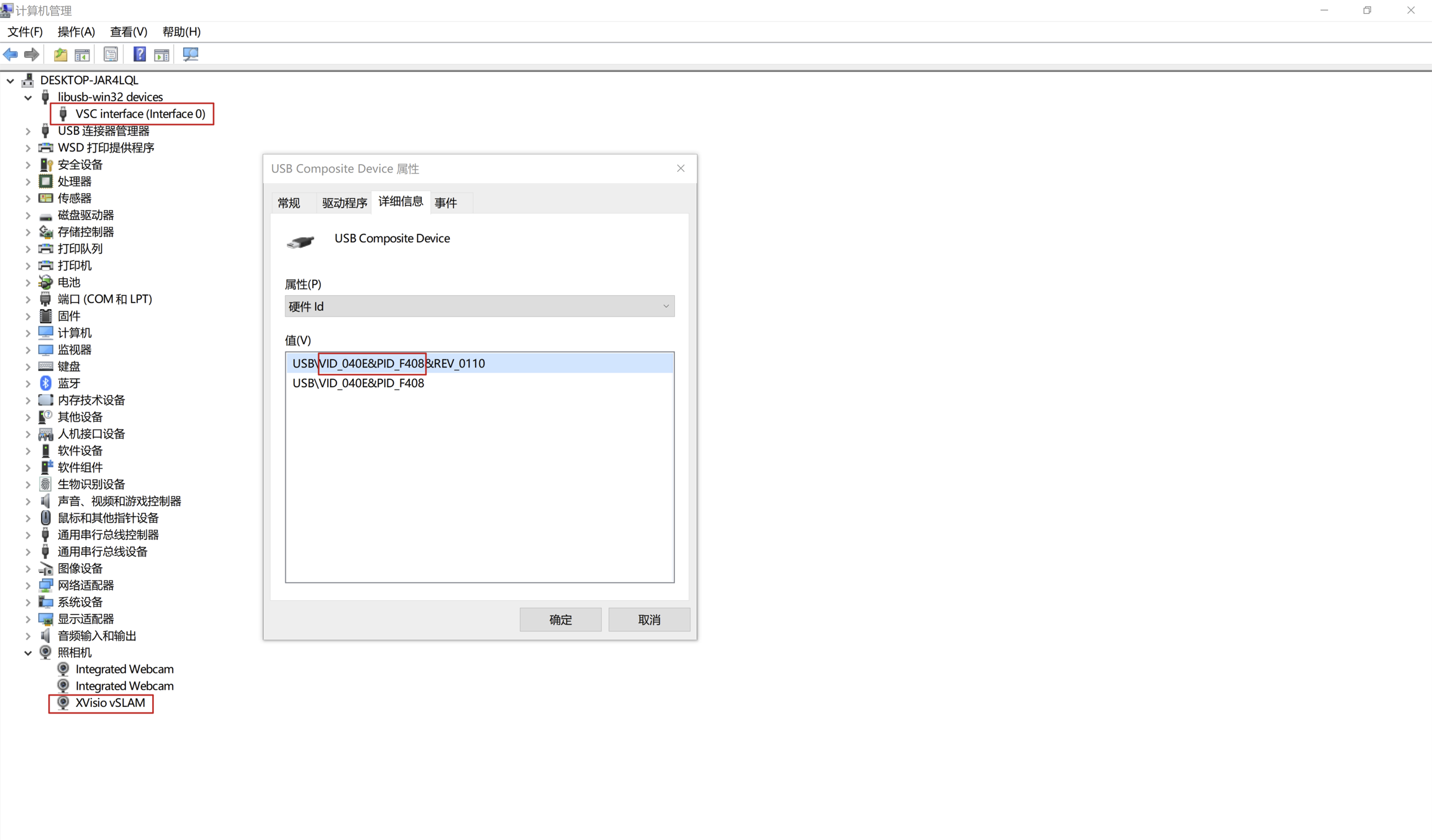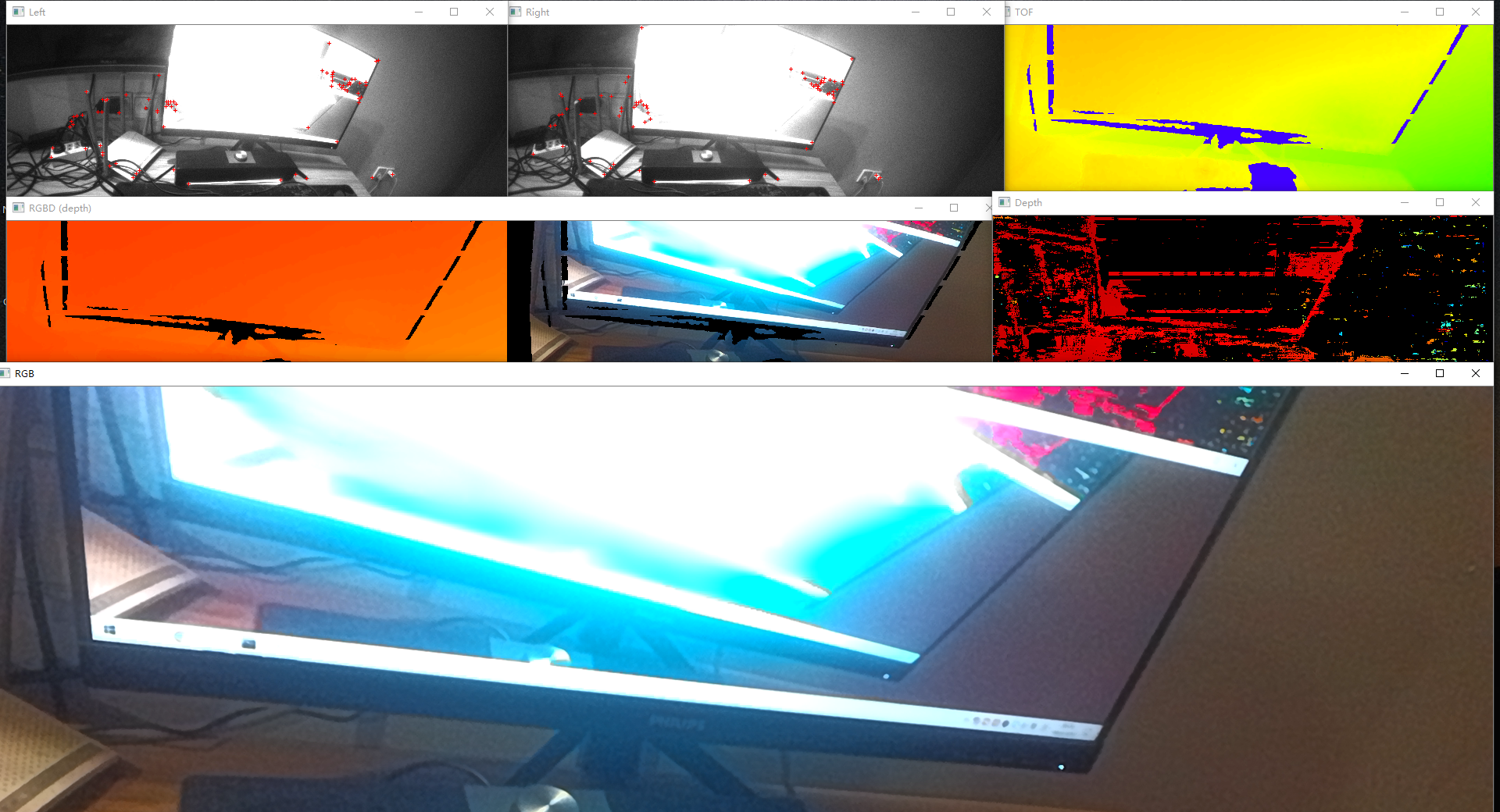← C/C++
← Xvisio SDK Documentation Home Page
all_stream
1 Overview
"all_stream" demonstrates all the basic functions of Xvisio device and the corresponding SDK API, which also provides the sample code that corresponds to the execution function.
2 Build and Run
2.1 Linux/Ubuntu
2.1.1 Build Cmake
- Install Xvisio SDK in host Linux/Ubuntu. Refer to SDK Install Guide。
- Start the terminal and navigate to the installation path ("/usr/share/xvsdk/all_stream") of all_stream , or copy "/usr/share/xvsdk/all_stream" to work directory and then navigate to “all_stream".
cp -r /usr/share/xvsdk/all_stream <path_to_work>
cd <path_to_work>/all_stream - Cmake generates Makefile
mkdir build
cd build
cmake .. - Build
make
A successful build will generate an executable binary program called "all_stream".
2.1.2 Run
- Connect Xvisio device with Ubuntu host via USB cable.
- Check USB status, open terminal and input:
lsusb
Observe the terminal output usb status information where VID:PID is "040e:f408", and "MCCI XVisio vSLAM" indicates Xvisio device.
Confirm that the current device enumeration is USB3.0 or USB2.0 by the USB Bus number of the Xvisio device and the corresponding BUS HUB type.
Please ensure proper enumeration of Xvisio device
The above description is shown in the following figure:

- Start the terminal and navigate to <path_to_work>/all_stream/build
./all_stream
Before performing this step, you need to ensure that the program has been successfully built and generated an executable binary program named "all_stream".
After opening successfully, all function screens supported by the Xvisio device will be displayed.

2.2 Windows10/11
2.2.1 Build
- Install Xvisio SDK in Windows host. Refer to SDK Installation Guide。
- Enter into example catalog "all_stream" after SDK installed successfully. For example:C:\Program Files\xvsdk\samples\all_stream.
- Compile with visual studio
- Pre-install visual studio. Currently it supports version 2017 and 2019.click to download version 2019
- Pre-install cmake.click to download
- "cmake" to generate file "sln".
- Start tool "windows powershell" and navigate to "all_stream" catalogue.
- Execute the corresponding generate project command according to the current visual studio version:
Version cmake commands VS2019 6bit cmake -G "Visual Studio 16 2019" -A x64 VS2019 32bit cmake -G "Visual Studio 16 2019" -A Win32 VS2017 64bit cmake -G "Visual Studio 15 2017" -A x64 VS2017 32bit cmake -G "Visual Studio 15 2017" -A Win32 - Catalogue "all_stream" will generate file "all_stream.sln"
- Open "all_stream.sln" with visual studio.
- "all_stream.exe" will be generated in the corresponding directory once build successfully.
2.2.2 Run
- Connect Xvisio device with Windows host via USB cable.
- Connect the Xvisio device to PC via USB cable. Three devices should be listed if the Xvisio device is connected normally. You can check the device status through the device manager of the system:

Please check status of "VSC interface","XVisio vSLAM" or "USB Composite Device" if error appears. If the status is abnormal, please check whether the USB cable and Xvisio device firmware are normal, or whether the USB status of the Windows host meets the requirements. Or contact with Xvisio FAE for help。 - Start tool "windows powershell" to navigate to the installation directory "bin", input the .exe name and press "Enter":
./all_stream.exe
After opening successfully, all function screens supported by the Xvisio device will be displayed.

3 Code Introduction
3.1 Directory
| Platform | Directory |
|---|---|
| Windows | Installation directory samples\all_stream,for example:C:\Program Files\xvsdk\samples\all_stream\ |
| Linux/Ubuntu | /usr/share/xvsdk/all_stream/ |
3.2 File
| File | Description |
|---|---|
| all_stream.cpp | all_stream main file |
| fps_count.hpp | Class implementation file for calculating frame rate |
| raw2opencv.cpp | Dependent opencv implementation file |
| CMakeLists.txt | Cmake project file (valid with Android platform) |
3.3 Code Analysis and Introduction
"main(....)" is entry function in file "all_stream":
int main( int argc, char* argv[] ) try
"enableDevMap" controls the enable functions of "all_stream":
static std::map<std::string,int> enableDevMap;
enableDevMap["rgb"] = true;
enableDevMap["tof"]= true;
enableDevMap["fisheye"] = true;
enableDevMap["sgbm"] = true;
enableDevMap["slam"] = true;
enableDevMap["slam_edge"] = true;
enableDevMap["imu"] = true;
enableDevMap["eyetracking"] = true;
enableDevMap["sync"] = false;
enableDevMap["dewarp"] = true;
enableDevMap["VGA"] = true;
enableDevMap["720P"] = false;
enableDevMap["tof_mode"] = 3;//default lablize sf
enableDevMap["tof_point_cloud"] = false;
enableDevMap["log"]=true;
enableDevMap["ir"]=true;
The device description information can be set by adjusting the run-time parameters to control enable/disable function,see section 4 for a detailed description(Character control description):
if (argc >1 && *argv[1]!='\0') {
std::ifstream ifs( argv[1] );
if( !ifs.is_open() ){
std::cerr << "Failed to open: " << argv[1] << std::endl;
}
else
{
std::stringstream fbuf;
fbuf << ifs.rdbuf();
json = fbuf.str();
}
}
if (argc == 3)
{
std::string enableDevStr(argv[2]);
enableDevStr+=" ";
int index,index2;
while(true)
{
index = enableDevStr.find(' ');
if(index == std::string::npos)
{
break;
}
auto one = enableDevStr.substr(0,index);
index2 = one.find('':'');
auto key = one.substr(0,index2);
auto value = one.substr(index2+1,one.size()-index2-1)=="1"true:false;
enableDevStr = enableDevStr.substr(index+1);
std::cout<<key<<" : "<<value<<std::endl;
enableDevMap[key] = value;
}
}
Examples:
./all_stream test.json "rgb:1 tof:0 tof_mode:3"
Input control instruction, see section 4 for a detailed description(Character control description):
while(true)
{
if(res == xv::FisheyeCamerasEx::ResolutionMode::MEDIUM)
std::cerr << "ENTER 'f' to switch FE to HIGH res" << std::endl;
else
std::cerr << "ENTER 'f' to switch FE to MEDIUM res" << std::endl;
if(sgbm_ctl == true){
std::cerr << "ENTER 's' to stop SGBM to res" << std::endl;
std::cerr << "ENTER 'r' to modify SGBM resolution" << std::endl;
}
else{
std::cerr << "ENTER 's' to start SGBM to res" << std::endl;
}
std::cerr << "ENTER 'q' to exit" << std::endl;
std::cin >> getkey;
//getkey = std::cin.get();
if(getkey == "f")
{
res = (res == xv::FisheyeCamerasEx::ResolutionMode::MEDIUM)?(xv::FisheyeCamerasEx::ResolutionMode::HIGH):(xv::FisheyeCamerasEx::ResolutionMode::MEDIUM);
std::cout<<"device->fisheyeCameras())->setResolutionMode:"<<static_cast<int>(res)<<std::endl;
std::dynamic_pointer_cast<xv::FisheyeCamerasEx>(device->fisheyeCameras())->setResolutionMode(res);
}
else if(getkey == "s")
{
if(sgbm_ctl == false)
{
std::cout<<"device->sgbmCamera()->start(global_config)"<<static_cast<int>(res)<<std::endl;
device->sgbmCamera()->start(global_config);
}
else
{
std::cout<<"device->sgbmCamera()->stop()"<<static_cast<int>(res)<<std::endl;
device->sgbmCamera()->stop();
}
sgbm_ctl = !sgbm_ctl;
}
else if(getkey == "r")
{
sgbmres = (sgbmres == xv::SgbmCamera::Resolution::SGBM_640x480) ? xv::SgbmCamera::Resolution::SGBM_1280x720 : xv::SgbmCamera::Resolution::SGBM_640x480;
bool ret = device->sgbmCamera()->setSgbmResolution(sgbmres);
if(ret){
std::cout << "device->sgbmCamera()->setSgbmResolution: " << static_cast<int>(res)<<std::endl;
}else{
std::cout << "device->sgbmCamera()->setSgbmResolution failed"<<std::endl;
}
}
else if(getkey == "q")
{
break;
}
}
All the images in "all_stream" are all drawing by OpenCV. It draws corresponding images through different overloaded functions "raw_to_opencv" processes different data.
Drawing Fisheye data by OpenCV:
cv::Mat left;
cv::Mat right;
if (stereo) {
auto const& leftInput = stereo->images[0];
auto const& rightInput = stereo->images[1];
if( leftInput.data != nullptr ){
left = cv::Mat::zeros(leftInput.height, leftInput.width, CV_8UC1);
std::memcpy(left.data, leftInput.data.get(), static_cast<size_t>(left.rowsleft.cols));
}
if( rightInput.data != nullptr ){
right = cv::Mat::zeros(rightInput.height, rightInput.width, CV_8UC1);
std::memcpy(right.data, rightInput.data.get(), static_cast<size_t>(right.rowsright.cols));
}
} else {
left = cv::Mat::zeros(400, 640, CV_8UC1);
right = cv::Mat::zeros(400, 640, CV_8UC1);
}
cv::cvtColor(left, left, cv::COLOR_GRAY2BGR);
cv::cvtColor(right, right, cv::COLOR_GRAY2BGR);
Drawing according to feature points:
if (keypoints) {
const int size = 2;
int s=0;
for(unsigned int i=0; idescriptors[s].size; i++ ){
auto p = keypoints->descriptors[s].keypoints.get() + i*2;
cv::Point pt(*p, (p+1));
cv::line(left, pt - cv::Point(size,0), pt + cv::Point(size,0), cv::Scalar(0,0,255) );
cv::line(left, pt - cv::Point(0,size), pt + cv::Point(0,size), cv::Scalar(0,0,255) );
}
s=1;
for(unsigned int i=0; idescriptors[s].size; i++ ){ 2;
auto p = keypoints->descriptors[s].keypoints.get() + i
cv::Point pt(*p, *(p+1));
cv::line(right, pt - cv::Point(size,0), pt + cv::Point(size,0), cv::Scalar(0,0,255) );
cv::line(right, pt - cv::Point(0,size), pt + cv::Point(0,size), cv::Scalar(0,0,255) );
}
}
4 Character control description
Before all_stream starting, you can set runtime parameters to control whether the feature is enabled or disabled, as described below:
| Parameters | Default Value | Remark |
|---|---|---|
| rgb | true | Adjust this parameter to enable or disable rgb |
| tof | true | Adjust this parameter to enable or disable tof |
| fisheye | true | Adjust this parameter to enable or disable fisheye |
| sgbm | true | Adjust this parameter to enable or disable sgbm |
| slam | true | Adjust this parameter to enable or disable slam |
| slam_edge | true | Adjust this parameter to enable Edge mode or Mixed mode if it is false |
| imu | true | Adjust this parameter to enable or disable imu |
| eyetracking | true | Adjust this parameter to enable or disable eyetracking |
| sync | false | This parameter determines whether to enable the synchronization mode. By default, the synchronization mode is disabled |
| dewarp | true | Adjust this parameter to determine whether image distortion is enabled. This parameter is enabled by default. If flat angle lenses are used, this parameter is not required |
| VGA | true | Adjust this parameter to set the fisheye camera resolution to VGA(640*400) |
| 720P | false | Adjust this parameter to set the fisheye camera resolution to 720P(1280*720) |
| tof_mode | 3 | Adjust this parameter to set tof mode,IQMIX_DF = 0,IQMIX_SF = 1, LABELIZE_DF = 2,LABELIZE_SF = 3,M2MIX_DF = 4,M2MIX_SF = 5. By default is LABELIZE_SF mode |
| tof_point_cloud | false | Adjust this parameter to determine whether to obtain TOF point cloud data. The default value is not obtained |
| log | true | Adjust this parameter to determine whether to output log |
| ir | true | Adjust this parameter to enable or disable tof IR |